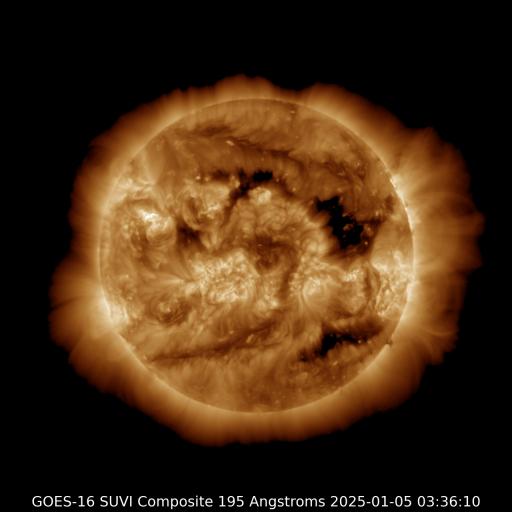Viewing archive of Friday, 15 January 2021
Daily bulletin on solar and geomagnetic activity from the SIDC
Issued: 2021 Jan 15 1230 UTC
SIDC Forecast
Solar flares
Quiet conditions (<50% probability of C-class flares)
Geomagnetism
Quiet (A<20 and K<4)
Solar protons
Quiet
| 10cm flux | Ap | |
|---|---|---|
| 15 Jan 2021 | 074 | 003 |
| 16 Jan 2021 | 074 | 004 |
| 17 Jan 2021 | 074 | 010 |
Bulletin
Solar activity was at very low levels. A few very faint presently unclassified and unnumbered sun spots have emerged on the solar disc without showing signs of activity. No significant flares were detected in the last 24 hours and none are expected in the next 24 hours. No Earth- directed coronal mass ejections (CMEs) were detected in the available coronagraph imagery.
The greater than 10 MeV proton flux was at nominal levels in the past 24 hours and is expected to remain so in the next 24 hours. The greater than 2MeV electron flux remained under the 1000 pfu threshold and is expected to remain so in the next 48 hours. The 24h electron fluence was at nominal levels and is expected to remain so.
Over the past 24 hours the solar wind parameters (ACE and DSCOVR) returned to undisturbed slow solar wind conditions. Both the total magnetic field and its Bz component remained very weak, varying in the range of 0.5 nT to 5.5 nT and -3.5 nT to 5.4 nT, respectively. The phi angle changes from the positive to the negative sector as the influence of the positive polarity coronal hole faded away. The solar wind speed gradually decreased from about 360 km/s to 300 km/s.
Quiet geomagnetic conditions were observed over the past 24 hours and quiet conditions are expected in the next 48 hours. A higher latitude extension of the negative polarity southern polar coronal hole has crossed the central meridian over the night. With respect to that quiet to unsettled conditions might be expected in the late evening of Jan 17th and quiet to active conditions are expected for Jan 18th as the HSS originating from this coronal hole reaches Earth.
Today's estimated international sunspot number (ISN): 019, based on 10 stations.Solar indices for 14 Jan 2021
| Wolf number Catania | 000 |
| 10cm solar flux | 074 |
| AK Chambon La Forêt | 005 |
| AK Wingst | /// |
| Estimated Ap | 002 |
| Estimated international sunspot number | 004 - Based on 21 stations |
Noticeable events summary
| Day | Begin | Max | End | Loc | Strength | OP | 10cm | Catania/NOAA | Radio burst types | |
|---|---|---|---|---|---|---|---|---|---|---|
| None | ||||||||||
Provided by the Solar Influences Data analysis Center© - SIDC - Processed by SpaceWeatherLive
All times in UTC
Current data suggests there is a slight possibility for aurora to appear at the following high latitude regions in the near future
Gillam, MB, Iqaluit, NUNuuk
Reykjavik
Latest news
Latest forum messages
Support SpaceWeatherLive.com!
A lot of people come to SpaceWeatherLive to follow the Sun's activity or if there is aurora to be seen, but with more traffic comes higher server costs. Consider a donation if you enjoy SpaceWeatherLive so we can keep the website online!

Latest alerts
00:55 UTC - Coronal hole
A southern hemisphere coronal hole is facing Earth. Enhanced solar wind could arrive in ~3 days
Monday, 7 April 2025
20:45 UTC - Geomagnetic activity
Active geomagnetic conditions (Kp4) Threshold Reached: 20:39 UTC
17:33 UTC - Hemispheric Power Index
The OVATION model predicts the Hemispheric Power Index to reach 51GW at 18:18 UTC
Space weather facts
| Last X-flare | 2025/03/28 | X1.1 |
| Last M-flare | 2025/04/05 | M1.0 |
| Last geomagnetic storm | 2025/04/06 | Kp5 (G1) |
| Spotless days | |
|---|---|
| Last spotless day | 2022/06/08 |
| Monthly mean Sunspot Number | |
|---|---|
| March 2025 | 134.2 -20.4 |
| April 2025 | 148.7 +14.5 |
| Last 30 days | 134.1 -5.6 |




